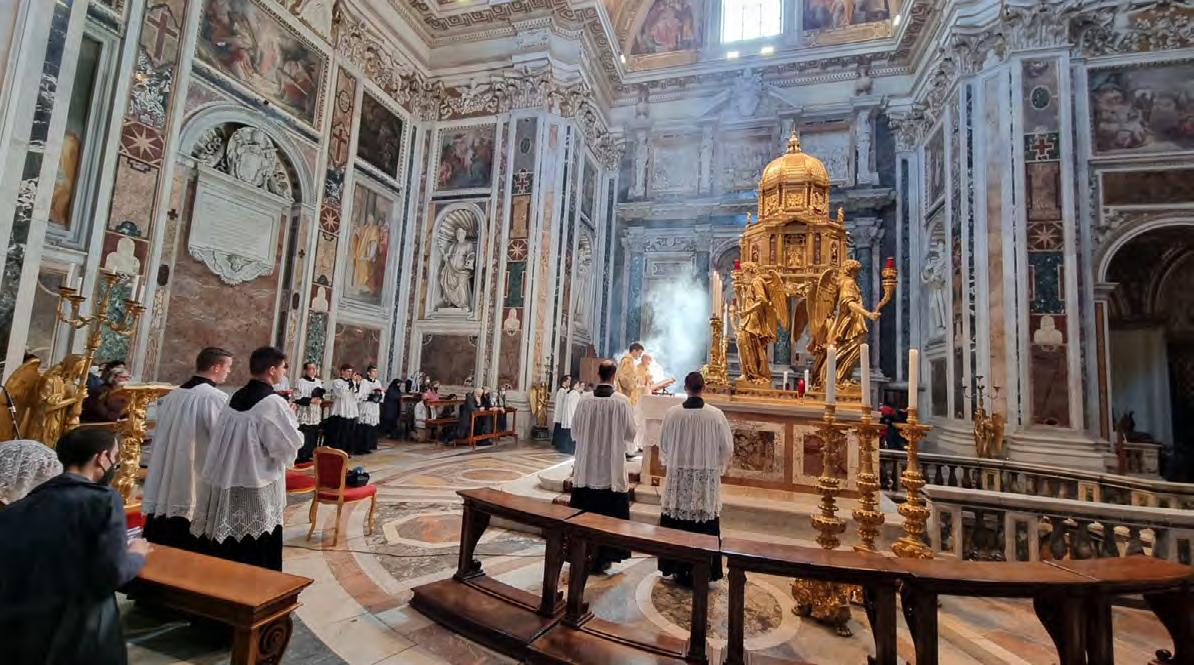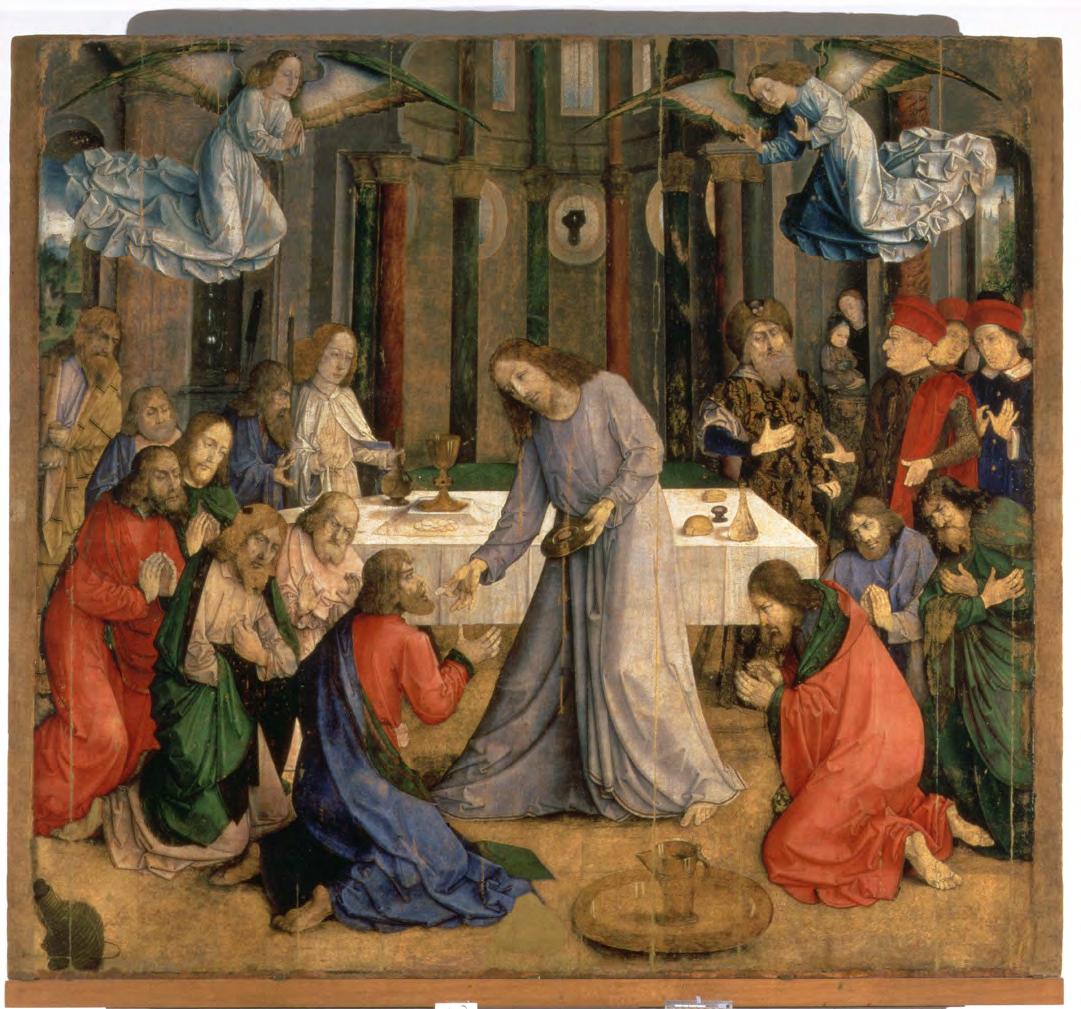
7 minute read
Lex Orandi, Lex Credendi
David Gornall SJ on finding the truth in the middle way
We might express the ancient adage, Lex Orandi, Lex Credendi!, as, “The way we pray reflects the way we believe”, or maybe even more relevant to our present situation, “Our style of worship indicates the faith we profess”. This is clearly applicable to the present Church situation regarding the not-alwayscharitable relationship between the Traditional Latin Mass and the Novus Ordo Mass generally celebrated in the vernacular, and which Pope Francis (in Traditionis Custodes) has declared to be the normative ‘Lex Orandi’ of the Roman Rite (or as Vatican II puts it paradoxically, the “Latin” rites – Sacrosanctum Concilium 36,1)! It would be good for us to get beyond the emotively highly charged liturgical camps promoting and defending either form of the Mass, and to uncover what is below the surface of the issues involved.
The issues involved here are of significant importance given the catastrophic decline of the Catholic Church in the Western world in the decades since Vatican II. An overwhelming proportion of the two generations of ‘parents’ and ‘youngsters’ today have been for practical purposes lost to the Church. Statistics bear this out particularly with regard to Mass attendances, numbers of Weddings, Confessions and Confirmations, and personal experience in our churches corroborate these indicators. Especially concerning is the very low proportion of ‘Catholic’ school leavers who go on to practise the Faith, this of course being a reflection of the situation with their parents. Obviously, despite the many other factors in our secularised society drawing people away from religious practice, the reforms ‘in the spirit’ of Vatican II have not been adequate to engage these generations in a robust practice of the Faith. This remains true despite the devout faith of those who do find spiritual nourishment in the reformed, or Novus Ordo, Mass which is generally celebrated. In face of these phenomena, the Traditional Latin Mass (or Tridentine Mass) has grown in popularity, not least with many of the younger generation. Given this scenario, Traditionis Custodes has sadly led to a veritable campaign against the TLM in many dioceses of the Church, and great anxiety among its devotees. How should we regard this situation in which we find ourselves?
Few would deny that a good deal depends on the style of celebration of the particular liturgy – the personal ‘devotion’ of the celebrant in both forms of the Mass is significant. Even strong critics of the Novus Ordo admit that this Mass can be spiritually nourishing when celebrated in a devout way, and without personal ‘gimmicks’ on the part of the celebrant. And virtually all admit its validity. Of course, the majority of those who support and revere the Old Mass nevertheless attend the Novus Ordo most of the time, given the geographically limited availability of the TLM. This is something which most of the bloggers promoting the TLM give scant acknowledgement to, given their obvious situations of ready availability of the TLM. And even here, some devotees have deplored celebrants who ‘rattle-off’ the TLM at a lightening rate, which doesn’t help devotion on the part of congregations.
It has to be admitted, also, that the individualism of many celebrants of the Novus Ordo Mass has given rise to much of the criticism directed at the New Mass. This has undoubtedly been encouraged by the rubrics and many ‘options’ of the rite, these clearly giving great scope to the personal choice of the celebrant. From this, it is a small step to the liturgical ‘creativity’ unfortunately too common among not a few celebrants today, and the liturgical ‘abuses’ so strongly excoriated by the bloggers mentioned above. Sadly, this has often been tolerated and even at times encouraged by some diocesan bishops. It is not surprising, therefore, that the clearly-defined and solemn celebration of the TLM has attracted many in reaction to the lack of devotion and sense of the sacred of very many Novus Ordo Masses.
At this point, it is relevant to note the significant and huge differences between what the document on the Liturgy of Vatican II (Sacrosanctum Concilium) actually says and the reforms “in the spirit of Vatican II” which were promulgated after the Council. Dr Taylor Marshall in his book Infiltration documents this whole process in detail, and we are indebted to him for this. ‘Reforms’ involved which were not specified by the Vatican II document include the virtually complete replacement of Latin by the vernacular and the virtual exclusion of Gregorian chant, the celebration of Mass facing the people and the introduction of freestanding ‘table’ altars, the removal of altar rails, the reception of Holy Communion in the hand and standing, the introduction of Extraordinary Lay Ministers of the Eucharist (men and women) and so on. That all these changes are defended and promoted ‘in the name of Vatican II’ is, to say the least, egregious. They witness to the influence of liberal theologians and liturgists in the years following the Council.
Focusing especially on the celebration of Holy Mass, it may be rather unnerving to realise that the ‘lex orandi, lex credendi’ is in operation here – witnessing to a different theology of the Mass on the part of the celebrants and faithful involved.
Most obvious, is the issue of ‘focus’ – the Novus Ordo Mass as generally celebrated facing the people, tends to focus on the worshipping community, while the TLM by its physical alignment ‘ad orientem’ focuses on worship of Almighty God. Not surprisingly, therefore, many are attracted to the TLM by its solemn and ‘sacred’ character. Also, the focus on the Sacrifice of Christ on the Cross, made present in the Mass for our Salvation, is very often lost in the Novus Ordo celebration. The way of receiving the Holy Eucharist in the Novus Ordo Mass can easily lead to a lack of faith in the Real Presence of Christ in Holy Communion, on the part of those receiving, as the manner of receiving is how we receive ordinary food. We may note, here, the ‘casual’ manner in which many of the faithful receive Holy Communion, and even at times the way it is administered by clergy and lay ministers. Shock waves were caused in America a few years ago when a survey indicated that hardly one third of practising Catholics believe in the Real Presence of Christ in the Eucharist, rather seeing it as a ‘Symbol’, as do most Protestants!
Here, we might examine what is perhaps the key issue for the future liturgy of the Church, and which is sadly misrepresented by many on both sides of the debate: namely, is the post Vatican II Novus Ordo Mass a ‘disruption’ of the liturgical tradition of the Church, or is it in ‘continuity’? Clearly, from the externals of language and ritual, it is a disruption. However, from the point of view of doctrine, it is without doubt in continuity, as witnessed by even its opponents accepting its validity. Even the aspect of ‘Sacrifice of Christ’ for our salvation, while often obscured by the actual celebration, is nevertheless stated in various prayers of the Novus Ordo.
Consequently, despite the ‘eitheror’ stance of the present pontificate on the issue, we might well prefer rather the Benedict XVI solution put forward in his liberating document allowing widespread celebration of the TLM, that it should be more of a ‘both-and’ situation and that each form might then be enriched by the other. The witness of history would support this, for the future never reverts wholeheartedly to the past, but ought rather to embrace the life-giving elements from it. The Hegelian dialectic also would indicate this outcome, for while there has undoubtedly been an extreme reaction to the old order (a ‘swinging of the pendulum’), the healthy and desirable and practical outcome would be a solution somewhere ‘in the middle’.
Or, as the old philosophers would put it, “Virtus stat in medio”!
Suggested reading:
Bishop Athanasius Schneider, The Catholic Mass and Christus Vincit Taylor Marshall, Infiltration All available from the LMS online shop.











